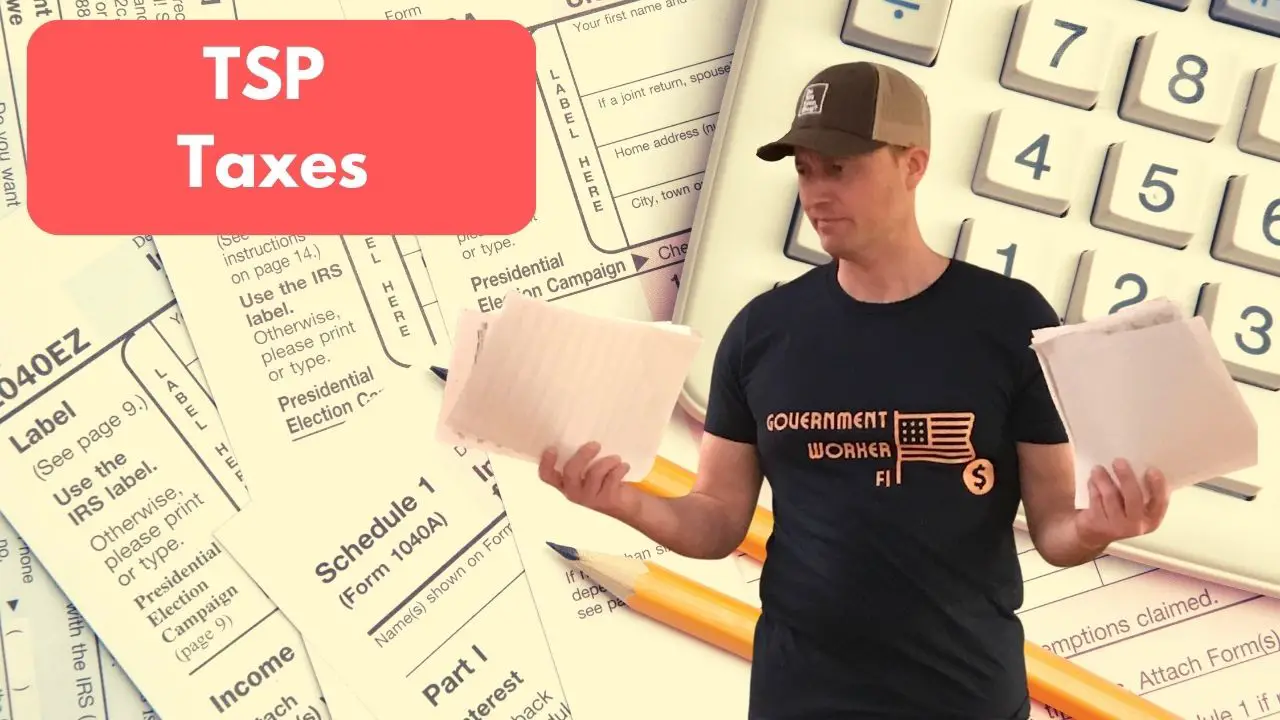“Few understand this”
If you’ve spent any time with a crypto enthusiast, I’m sure you’d have heard them say that phrase when you’ve questioned their beliefs.
But according to my research, I think there are (too) few federal employees that understand the differences between the TSP and an IRA.
In this post, I go deep into the differences between TSPs and IRAs. Hopefully by the end, you’ll understand the differences between the TSP and and IRA and how to use both to rock your retirement planning.
Get Gov Worker’s top 4 tips for federal employees!Table of Contents
- The Thrift Savings Plan (TSP) is Not an IRA
- What is the TSP?
- 5 Major differences between an IRA and the TSP
- 0. The TSP has a government match on contributions.
- 1. IRAs and the TSP have different annual contribution limits
- 2. You can make TSP withdrawals at age 55
- 3. The TSP allows you to use funds to purchase a home
- 4. You can borrow money from your TSP
- 5. You can withdrawal money from an IRA to pay for college
- Reasons you may wish to roll a TSP into an IRA
- Reasons you may wish to transfer an IRA to the TSP
- Things to consider before moving money between the TSP and an IRA
- Summary: You probably want to have both an IRA and a TSP
Please do not confuse my personal blog for financial advice, tax advice or an official position of the U.S. Government. This post may contain affiliate links. If you make a purchase after clicking on a link, I get a small percentage of the sale at no additional cost to you.
The Thrift Savings Plan (TSP) is Not an IRA
I can understand why you might be confused. Both the Thrift Savings Plan (TSP) and an Individual Retirement Account (IRA) help people save for retirement.
However, there are several key differences between these types of accounts. Before you can optimize your retirement planning, you need to understand the difference between the TSP and an IRA.
Let’s start with the basics.
What is the TSP?
The TSP is an employer sponsored qualified retirement plan. It is similar to a 401(k) for federal civilian employees and those in the uniformed services. Both a TSP and 401(k) have the same contribution limits ($20,500 in 2022).
Federal employees contribute to the TSP through payroll deduction. For FERS employees, the government will match the first 5% of your salary that you contribute each pay period.
CSRS employees can contribute to a TSP but they do not receive employer matching.
While the TSP has many similarities with a 401(k), there are some key differences when it comes to withdrawing money from the TSP.
The TSP has limited investment options. TSP contributions can be invested in one of 5 TSP Funds or Lifecycle Funds.
Tax advantages of the the TSP
You have 2 options as a federal employee: a “traditional TSP” and a “Roth TSP”
With the traditional TSP, your contributions are not taxed which lowers your taxable income while you are working. Traditional TSP withdrawals are taxed in retirement.
In contrast, Roth TSP contributions receive no tax break. However, you do not pay taxes on them in retirement. Matching contributions, made by your agency, are treated as traditional TSP contributions. As a result, your TSP will have both a tax-exempt balance and a tax-deferred balance.
Which type of TSP you should contribute to depends on what tax bracket you are in now, what tax bracket you expect to be in when you retire, and your life expectancy, among other factors. I made this guide comparing the traditional and Roth TSP to help you better understand this choice.
What is an IRA?
Anyone with earned income in the United States can open an individual retirement account (or IRA). You can open an IRA at nearly any financial institution you want. Furthermore, you are not limited to a TSP fund but instead can invest in many types of securities.
IRAs have a similar tax benefit as TSP accounts. However, the maximum contribution is much less ($6,000 in 2022). The IRS also limits who can receive tax benefits on their contributions based upon your earned income.
You can have both a TSP and an IRA
You don’t need to choose between these accounts. You can have a part of your retirement nest egg in the TSP and part within an IRA (or Roth IRA).
In fact, having both gives you the best of both worlds. While both the TSP and IRA are retirement accounts, they have small quirks that make them slightly different.
5 Major differences between an IRA and the TSP
0. The TSP has a government match on contributions.
Before splitting hairs on the details between the accounts, let’s review the obvious.
If you work for the federal government, they will match the first 5% of your pay that you contribute through agency contributions.
If you’re just starting as a federal employee and you can only have one account, you should definitely contribute to the TSP up to the match amount.
1. IRAs and the TSP have different annual contribution limits
You can contribute up to $20,500 in the TSP ($788 per pay period) and up to $6,000 in an IRA. (Employees over the age of 50 can make “catch-up contributions” to their TSP account as well).
Also, you may be eligible to contribute to the TSP if you are not eligible to contribute to a traditional or Roth IRA.
Federal employees eligible for the TSP can contribute up to $20,500 in a traditional or Roth TSP.
However, you may only receive a tax benefit on a traditional IRA contribution if your Modified AGI is less than $68,000 per year if single ($109,000 married filing jointly). Likewise, you are only eligible to contribute to a Roth IRA if you have a Modified AGI of less than $129,000 per year ($204 if married filing jointly).
2. You can make TSP withdrawals at age 55
For most retirement accounts, you need to be age 59.5 to withdrawal money without penalties. However, the TSP has some special withdrawal options that allow you to access some of the money earlier without penalties.
One advantage of the TSP is that you can withdraw at age 55 if you, “separate from service during or after the year the employee reaches age 55“.
If you are planning on leaving at your minimum retirement age, you can access all of the funds in your TSP before you are age 59.5.
3. The TSP allows you to use funds to purchase a home
One benefit of the TSP over an IRA is that it allows two types of loans.
As a TSP participant, you can remove up to $50,000 without an early withdrawal penalty to put towards the purchase of your primary residence. (If you have a low TSP account balance, you may not be able to take out a $50,000 loan). Residential TSP loans have a term of up to 15 years.
This is not a hardship withdrawal, but rather a loan that you are taking from your own TSP account. TSP loans are therefore not a taxable distribution.
While the interest rates on TSP loans can be very low, you are borrowing against your retirement savings. (Given the C fund returns, a ~1% interest rate on a TSP loan is more like a 15% real interest rate).
However, if you have no other options, it is good to know that you can get (up to) $50,000 to put toward the purchase price of your primary residence.
4. You can borrow money from your TSP
In addition to home loans, the TSP also allows personal loans for any reason. You do not need to provide any other documentation.
Unlike residential loans, the personal loans have a maximum term of 5 years. There are rules about how many outstanding loans you have taken from the TSP.
You can borrow up to $50,000 from the TSP, however this amount may reduced if you have an outstanding TSP Loan.
If you fail to pay back the loan, they will count as an in-service withdrawals, face an additional 10% penalty, and you will never be able to return that money to your TSP account.
5. You can withdrawal money from an IRA to pay for college
While the TSP has several loan options, you can withdraw money prior to retirement age with an IRA for college.
You are allowed to withdraw money from an IRA or Roth IRA to pay for qualified education expenses without the 10% early withdrawal penalty. Not only can you pay for your own education expenses, but also your spouse’s or children’s educations. This is unique to IRAs and not a TSP option.
Note that if you are withdrawing money from traditional contributions, you will have to pay income tax (but not a penalty) on the withdrawals.
Reasons you may wish to roll a TSP into an IRA
1. An IRA will give you more investment options
I think of IRAs and TSPs as an imaginary box drawn around some of your money. They money in the box has special tax treatment that the money outside the box does not.
There are only 5 individual TSP funds. With an IRA you have many more options.
Most IRA providers will allow you to buy individual stocks and/or trade options. But certain IRA providers will allow you to hold unusual assets within your IRA.
For example, some companies will allow you to hold and trade cryptocurrencies within your IRA.
And RocketDollar™ will allow you to hold nearly any asset (including real estate) within your IRA.
Note: Please consider your risk tolerance before rolling over your TSP to a high/risk high/potential reward asset class. I believe that nearly everyone can achieve their retirement objectives through investing within the TSP.
2. An IRA will give you more flexibility on your withdrawals
Although the TSP modernization act made TSP withdrawals a lot more flexible, it is not easy to withdraw money from the TSP in retirement.
You are limited in the frequency of withdrawals.
- If you elect a single payment, you may not receive 2 payments within 30 days.
- You may also set up withdrawal elections of monthly payments, quarterly payments, or annual payments.
Furthermore, you are not allowed to withdraw money from a specific fund. However you can choose whether the payments come from the traditional balance, Roth balance, or both.
Example: You have a portfolio of 60% C Fund, 10% I Fund, 10% S Fund, 10% F Fund, and 10% G Fund, and you withdrawal $10,000. The TSP will sell $6,000 of C Fund, $1,000 I Fund, $1,000 S Fund, $1,000 F Fund and $1,000 G Fund.
With an IRA you can sell whatever assets you want whenever you want to and make as many withdrawals as you want (unless your IRA provider has a limit on withdrawals).
The Roth TSP has required minimum distributions (RMDs)
Both IRAs and the traditional TSP require you to take RMDs when you reach age 72. However, Roth TSPs and Roth IRAs differ in that the Roth TSP requires you to take an RMD. In contrast, you can keep your entire Roth IRA balance intact until you die.
If you have a Roth TSP, you may wish to roll it into a Roth IRA upon separation to avoid RMDs.
Reasons you may wish to transfer an IRA to the TSP
1. You have access to the G Fund
There is nothing quite like the G Fund outside of the TSP. The G Fund guarantees the return of long term treasuries but you can move in and out of it like a short term investment. You earn a guaranteed positive return. (Although returns can be negative after inflation).
The G Fund has the safety of a certificate of deposit or money market account, but with better returns.
If you rollover all of your TSP assets to an IRA, you will lose access to this fund.
2. You have an IRA that has high fees
You can also roll an IRA into the TSP.
Perhaps you have an IRA that your family’s trusted advisor set up for you when you were young. Let’s say you look under the hood and see that your advisor is charging a 1% administrative fee and a 5% load on the mutual fund purchase. These fees will absolutely kill your retirement savings.
You can roll this IRA into the TSP and enjoy the extremely low 0.05% fees.
3. You want to purchase a TSP annuity
The TSP allows you to purchase an annuity upon retirement. Rolling money from an IRA into the TSP could allow you to purchase a larger annuity. However, before making any moves you should read my post about why most federal employees should avoid TSP annuities.
Things to consider before moving money between the TSP and an IRA
1. Potential tax penalties with an indirect rollover
If you do decide to do a TSP transfer to an IRA, you should understand the tax consequences. If you are transferring a tax-deferred contribution (from a traditional TSP) it is best to do a direct rollover. (Where the TSP directly transfers the pretax contributions to the new IRA provider).
If you opt for an indirect rollover, the TSP will mail you a check that you need to deliver to the new IRA provider within 60 days.
If you fail to complete the transfer within 60 days, it will count as a complete liquidation of your TSP for income tax purposes and you will be taxed on the entire distribution and receive an additional 10% penalty.
2. Investment advisors and conflicts of interest
Finally, if someone is pressuring you to rollover your TSP to an IRA, you should understand their motivation.
As a military or civilian employee you may look like an easy target to an unscrupulous financial advisor since they know you have a generous eligible employer plan. They may want you to perform a TSP withdrawal so they can get a cut off of your administrative expenses under your new IRA.
You worked hard to save your retirement funds and I would hate for them to be swindled from you. One advantage of federal service is that the government set up a retirement plan that’s built for average federal government employees to succeed. Make sure you know what you are doing before changing your investment plan to private corporations.
Get Gov Worker’s top 4 tips for federal employees!Summary: You probably want to have both an IRA and a TSP
Hopefully by now you understand that a TSP and an IRA are completely different types of tax advantaged accounts.
Because there are slight differences in the tax treatment, you can utilize both accounts in your investment strategy.
And as long as you don’t roll over your entire account balance, you can always roll money back into the TSP (from an IRA).
Want to learn more? Check out my TSP School or my Facebook Group .

![Is the TSP an IRA? [Ultimate Guide] 1 This graphic compares the differences between the TSP and an IRA. The TSP is not an IRA.](https://cdn-0.governmentworkerfi.com/wp-content/uploads/2021/12/TSPvsIRA-682x1024.jpg)



